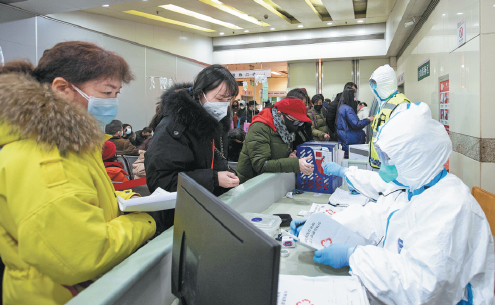Measures urgently needed to stop virus spreading in HK
China Daily Asia | Updated: 2020-01-24 11:26

The Wuhan pneumonia outbreak has taken a turn for the worse with a sudden surge in the number of infections over the past two days. Confirmed cases worldwide have surpassed 600, with 17 fatalities, by press time. Thursday’s confirmation of two cases of infection in Hong Kong brought back bad memories of the deadly SARS epidemic in 2003, stoking fear among local residents.
It is reassuring that the city’s health authority has responded swiftly and decisively, drawing on lessons learned from the SARS pandemic.
The Department of Health immediately put a mainland man in quarantine after he was detected with fever symptoms at the West Kowloon rail terminus on Tuesday. The health authority’s swift response demonstrated not only the efficacy of epidemic control at entry ports but also the smooth operation of our health alert notification system.
In another sign of the health authority’s readiness, the Centre for Health Protection has set up a hotline to track individuals at risk of infection. It has also set aside two holiday villages as quarantine centers. A special steering committee has also been set up to study other precautionary measures.
Yuen Kwok-yung, a specialist in infectious diseases and a professor at the University of Hong Kong, explained that the spread of the Wuhan coronavirus has undergone three stages. These are: transmission from animals to humans; a mini-outbreak in the neighborhood; and a large-scale outbreak in households and hospitals. He said the third stage was similar to the 2003 SARS outbreak. And clearly, there has been an outbreak on the mainland.
Although there are no signs of a communitywide outbreak in Hong Kong yet, we need to be on high alert as the risk of the virus spreading from imported cases is high. To prevent the virus spreading further, Hong Kong should boost efforts and precautionary measures in four areas.
First, health measures must be enhanced at all boundary control points. The health declaration requirement for incoming passengers should extend from the airport to all boundary control points, including the high-speed railway station. More health officers should be assigned to boundary control points to implement stricter body-temperature checks on passengers. This can be done both automatically and manually by increasing the number of staff patrolling entry points in order to spot possible flu patients. Every patient suspected of pneumonia must be quarantined immediately on the spot.
Second, a command center should be set up for optimizing the contingency strategy and quarantining virus carriers effectively. The Hospital Authority should be tasked to form the command center by recruiting some relevant experts. But if things get worse, Hong Kong Chief Executive Carrie Lam Cheng Yuet-ngor is expected to take charge.
The Hospital Authority should designate a number of hospitals with sufficient beds for accommodating pneumonic patients, and prepare place for quarantines. To prevent cross-infection, patients with respiratory symptoms should be treated at designated clinics. The health authority should also formulate a set of precautionary guidelines for public places such as hotels and shopping malls.
Third, the health authority should step up publicity efforts to alert all resident to the looming epidemic. An intensive publicity campaign is necessary to mobilize members of the public and keep them away from threat of the virus. The SAR government should realize that the public can only feel reassured when they are provided with timely and transparent information. As such, the government should be the only authorized source of anti-epidemic information. The government should also make public hygiene facilities, such as hand sanitizer dispensers, easily accessible where there are dense crowds — such as schools and shopping malls. To prevent panic purchases and steep price rises, the authority should also ensure a sufficient and steady supply of personal hygiene products, including surgical masks.
Fourth, the health authority must spare no effort to prevent an outbreak in hospitals; doctors and nurses must be sufficiently protected. Professor Yuen has warned that the city’s overcrowded public hospitals, with the bed occupancy rate often exceeding 100 percent during flu seasons, might fall short of protecting their medical teams in case of a major outbreak. Dr Zhong Nanshan, a mainland expert on anti-respiratory epidemics, has voiced the same concerns. Zhong said it is vital to prevent hospitals becoming a venue for virus transmission. The outbreak of Middle East respiratory syndrome in 2015 in South Korea, for example, saw some 30 doctors and nurses being infected at their workplaces.
To the relief of the public, the Wuhan virus is said to be much less virulent than the SARS one. With the lessons learned and experience gained from the 2003 SARS pandemic, the health authorities both in Hong Kong and the mainland are in a much better position to cope with the latest outbreak. With the cooperation of the public, the authorities are likely to get on top of this crisis soon. There is no need for Hong Kong residents to panic.
The author is a veteran current affairs commentator.
The views do not necessarily reflect those of China Daily.
























